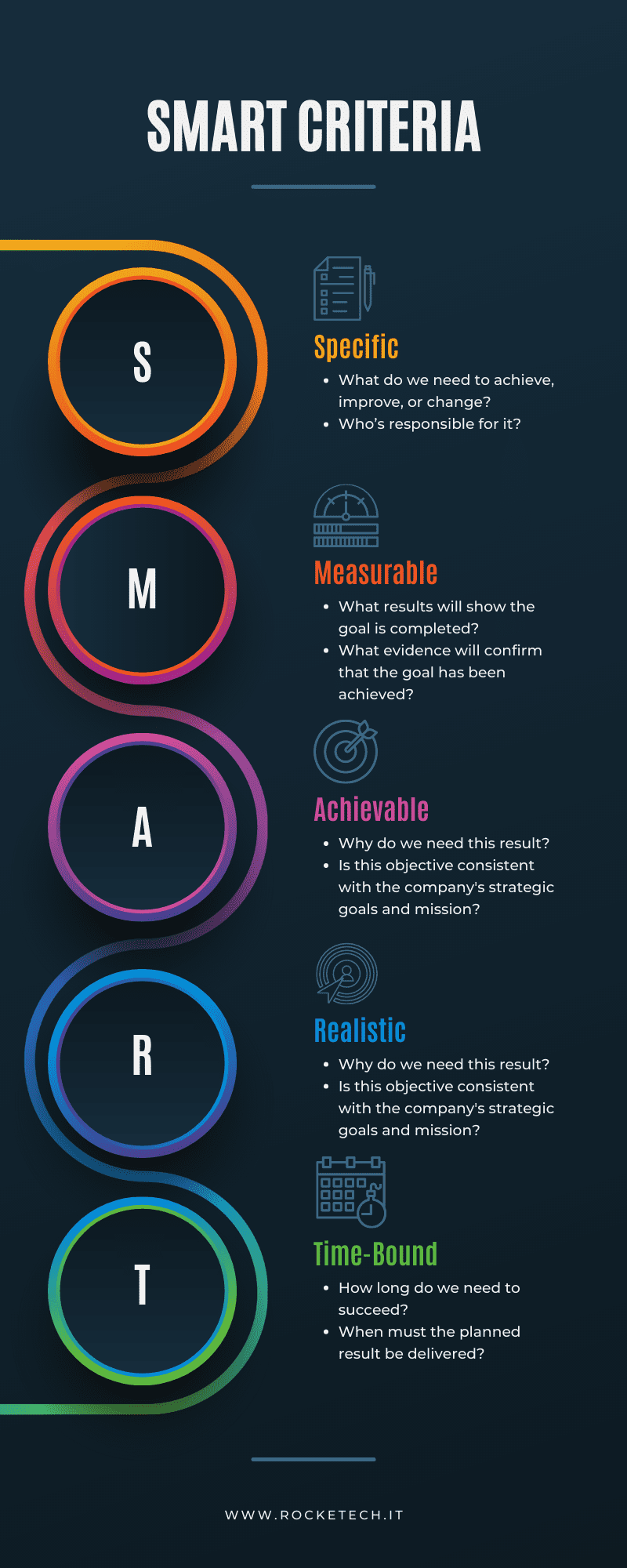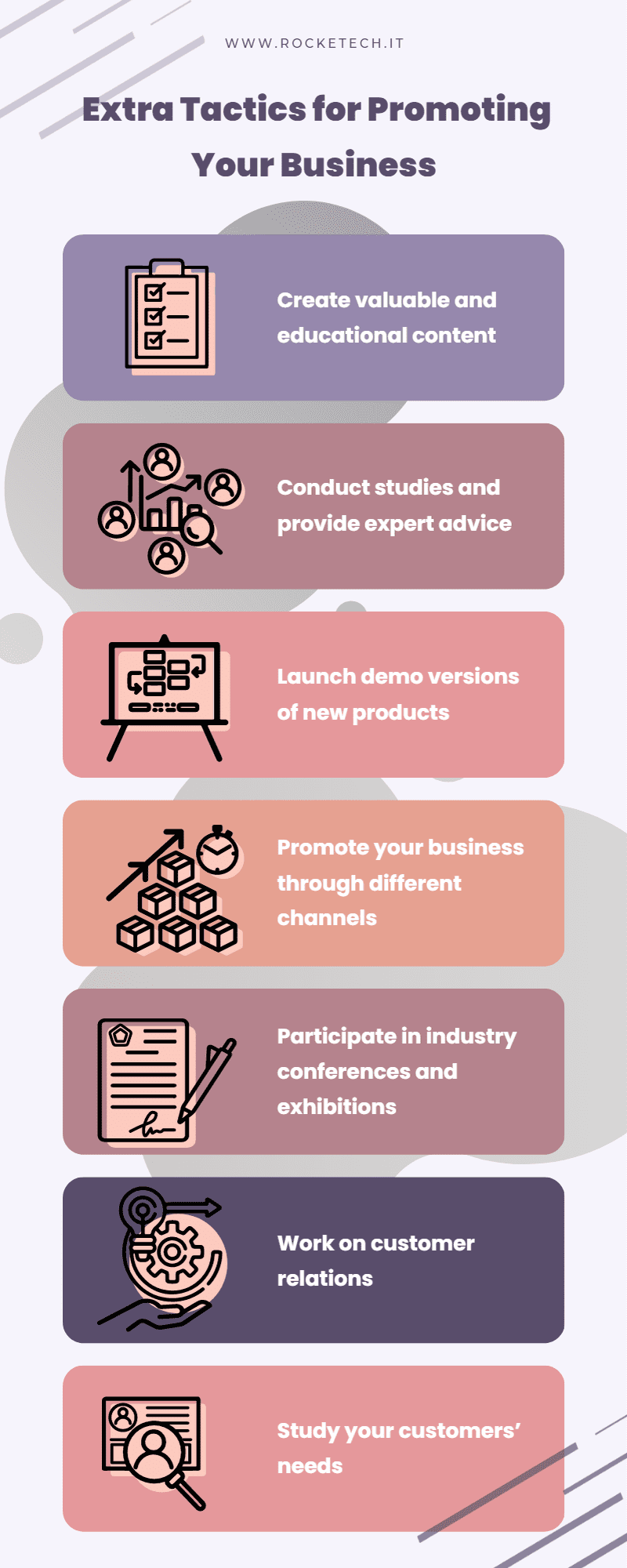Knowing how to grow businesses is essentially the transition to a new level. Successful entrepreneurs achieve it by making the right decisions. Moving forward “blindly” will most often lead to financial losses. A sound development strategy based on a preliminary analysis of the current situation helps you minimize the risks and grow your company quickly. We summed up seven tips for business success and effective scaling.

7 Tips for Business Owners and Startupers
Small and mid-sized businesses often disregard the concept of strategic planning considering it solely a prerogative of large corporations. In reality, every enterprise needs a strategy. The secret here is a comprehensive, multi-perspective approach.
#1 Set the Right Goals
Developing a company (or improving businesses in general) fast is impossible without clear objectives and a thought-through roadmap. And there are many ways to create it. In the early 1980s, George T. Doran introduced the SMART criteria for improved goal setting.
Simply put, it’s an objective description method that helps you make the planning more detailed and tangible or, more precisely, specific, measurable, achievable, realistic, and time-bound.

Imagine you opened a new business, a co-working space. Although you have a great place, modern equipment, and nice hosts, the business is not really developing. So far, you’ve managed to sign a contract with a few freelancers, but it’s barely enough to cover the running costs. Here’s how to set a SMART goal.
For example, “I need to attract 10 new regular customers within a month.” You can keep advertising the way you’ve done before and likely miss your objective in a month, or you can look for alternative ways. You can target professionals and organizations holding workshops or educational courses. Helping them will increase the company revenue and provide additional advertising as your customers will put your address to their promo content. Here, the time-bound factor and the specificity make you look for alternative ways to achieve your goal.
#2 Hire the Right Team (Which Knows How to Grow Your Business)
At the beginning of the journey, founders often do almost everything singlehandedly. However, as the famous saying goes, a Jack of all trades is also a master of none. When launching a business, it’s vital to assemble the right team. Essentially, by hiring your trusted team, you establish the company’s operations that become the driving force behind scaling in later stages.
#3 Research Your Competition
Let’s say you already have an established business. It’s been functioning for a couple of years. While everything seems fine, some metrics like customer lifetime value or customer retention rate are behind your planned business development stage. Most often, it means there are competitors (who grow quickly) with a better offer on the market. Analyzing the competition will help you win your customers back — to understand what attracts them most, make a unique offer, and create value.
Competitor analysis is integral when you take on something new and don’t know how to approach it. Besides understanding what makes your competitors successful, thorough market research helps you identify their weaknesses and win the customer by fixing them. Whether you start a social media promo campaign, prepare to launch a new website, or expand the product line, check how your competitors did it. This way, you can spot their mistakes and do things better.
#4 Diversify Your Offer
As the company grows, diversifying the offer becomes rather a necessity. What additional products, services, or even information can you offer your customers? Typically, at this stage, you already know your target audience. Now you need to analyze how they spend money and what else they can buy from you in one extended package.
| Remember: People value their time. If there’s an opportunity to buy three items in one place instead of three places for each item individually — most customers will prefer this option. |
Consider some of the popular tips for a small business you find online. You don’t have to radically expand your product offerings: follow the consumer logic, do a couple of studies, and build product or service packages that potentially appeal to your customers. Seasonal demand peaks are also an excellent chance to offer more and alternate the product line.
#5 Keep Improving Your Product
Constantly improving the quality of your product or services goes hand in hand with solid growth in business. If you are a manufacturer, buy better raw materials or parts. If you are a service provider, consider investing in upgrading employee skills or developing a new motivation system.
Even if there’s not much to do to improve the product itself, the business can always focus on customer interaction to increase service quality and satisfaction levels. The latter always leads to boosting retention rates. Remember, there are multiple ways to increase consumer spending while keeping your customer happy.
| The ideal offer formula: context + problem + customer pains + actions + profit. |
To follow the formula of an ideal offer, you need to already know your customers and their pains. That’s the point of your product or idea. However, you should always keep in mind that context and the ways your buyers solve their problems change. Your offer might become irrelevant in changed contexts and other circumstances impacted by external factors (take the global pandemic as an example).
#6 Adapt to Accelerate Business Growth
The recent events caused by the global pandemic have shown how important it is to quickly adapt to ever-changing conditions, whether economic or social. Companies that were not ready to promptly switch to a home office or build contactless or delivery services simply didn’t make it. While digitization is not new, thousands of enterprises still struggle to understand the importance of change.
First, you need to understand which external factors have affected the market to expand a company. Then compare your organizational system to the one required by the market. Simply put, any further strategy should be based on this comparison and the business environment assessment. Most often, you have to be ready to rebuild the organizational structure, business processes, and product line.
#7 Establish New Partnerships to Develop Your Business
Every modern market niche is intersected with related industries through thousands of invisible but solid connections. In fact, no business can survive solely on its own. For example, adherents of healthy lifestyles look for gyms, specific nutrition suppliers, and sports clothing stores in their neighborhoods. Segmenting your target audience by lifestyle, location, age, or income also helps identify potential strategic partnerships and understand how to grow a small business.
Affiliate programs with mutual advertising, joint promotions, and discount programs allow businesses to quickly expand the pool of customers and equally share the cost of attracting new customers between partners. Look for companies and entrepreneurs in your environment that can complement yours and offer opportunities for collaboration that will bring mutual profit.

How to Expand a Business: Final Thoughts
There are plenty of strategies for growing your business. However, it may be challenging to choose the right one, especially for aspiring entrepreneurs. Establishing a long-term partnership with a tech service provider is one of the ways to succeed by creating marketable digital products.
At Rocketech, we help startups find ideas with great potential and advise decision-makers on how to grow the business by implementing innovative tech solutions. Do you have questions about our services? Contact us for more information.